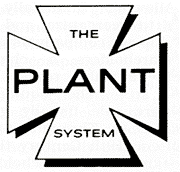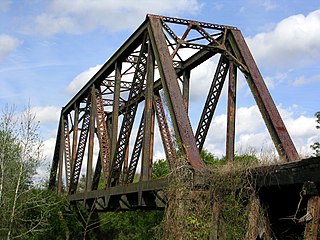
The Plant System, named after its owner, Henry B. Plant, was a system of railroads and steamboats in the U.S. South, taken over by the Atlantic Coast Line Railroad in 1902. The original line of the system was the Savannah, Florida and Western Railway, running across southern Georgia. The Plant Investment Company was formed in 1882 to lease and buy other railroads and expand the system. Other major lines incorporated into the system include the Savannah and Charleston Railroad and the Brunswick and Western Railroad.
The Brunswick and Western Railroad is a historic railroad in southern Georgia that at its greatest extent ran from Brunswick near the coast to Albany. Segments of the line still exist today. The Brunswick and Florida Railroad ran from Brunswick west to Glenmore, where it would connect with the Atlantic and Gulf Railroad.
The Florida Central and Western Railroad was a rail line built in the late 1800s that ran from Jacksonville west across North Central Florida and the part Florida Panhandle through Lake City and Tallahassee before coming to an end at Chattahoochee. The line was later part of the Seaboard Air Line Railroad network from 1903 to 1967, and was primarily their Tallahassee Subdivision. The full line is still in service today and is now part of the Florida Gulf and Atlantic Railroad.
The Callahan Subdivision is a CSX Transportation railroad subdivision within the Jacksonville Division on the former Seaboard Air Line Railroad. The sub extends northward 20 miles from Baldwin, Florida, where the Jacksonville Terminal Subdivision's S Line and Florida Gulf & Atlantic Railroad meet just north of Baldwin Yard, a classification yard. According to Jacksonville Division Timetable Number 4 published in 2005, the sub runs from milepost SM 0.18 to milepost SM 20.0, where it joins the Nahunta Subdivision, a former Atlantic Coast Line Railroad, in Callahan, Florida. The line serves as a bypass to Jacksonville.
The Tampa Southern Railroad was a subsidiary of the Atlantic Coast Line Railroad (ACL) originally running from Uceta Yard in Tampa south to Palmetto, Bradenton, and Sarasota with a later extension southeast to Fort Ogden in the Peace River valley built shortly after. It was one of many rail lines completed during the Florida land boom of the 1920s. Most of the remaining trackage now serves as CSX Transportation's Palmetto Subdivision. Another short portion just east of Sarasota also remains that is now operated by Seminole Gulf Railway.
The Jacksonville Terminal Subdivision is a group of railroad lines owned by CSX Transportation in and around Jacksonville, which was historically a major railroad hub. The Jacksonville Terminal Subdivision includes about 13.0 miles of track.

The Nahunta Subdivision is a railroad line owned by CSX Transportation in Florida and Georgia. The line runs along CSX's A Line from Ogeechee, Georgia, to Dinsmore, Florida, for a total of 129.2 miles (207.9 km). At its north end it continues south from the Savannah Subdivision and at its south end it continues south as the Jacksonville Terminal Subdivision A-Line. The line is double-tracked from Folkston, Georgia south. All of Amtrak's Florida service also traverses the line.
The Wildwood Subdivision is a railroad line owned by CSX Transportation in Florida. It runs along CSX's S Line from Baldwin south to Zephyrhills via Ocala and Wildwood for a total of 155.7 miles. The S Line is CSX's designation for the line that was the Seaboard Air Line Railroad main line from 1903 to 1967.
The Manchester Subdivision is a railroad line currently operated by CSX Transportation in Central Georgia. Its northern terminus is in Peachtree City, where it continues south from the Atlanta Terminal Subdivision. From Peachtree City, it runs for 38.8 miles (62.4 km) south to Manchester, Georgia, where it connects with CSX's Lineville Subdivision and Fitzgerald Subdivision. It is a major north-south route for CSX in Georgia.
The Tampa and Gulf Coast Railroad (T&G) was a railroad company in the Tampa Bay Area of Florida in the United States. It initially built and operated a line that ran from the Tampa Northern Railroad main line in Lutz west to Tarpon Springs and into Pasco County. Additional track starting from Sulphur Springs running west towards Clearwater and south to St. Petersburg was built shortly after. The railroad was informally known as the "Tug n' Grunt". While it was the second railroad to serve St. Petersburg and Clearwater after the Orange Belt Railway, it had the advantage of being the first to connect the area directly with Tampa.
The Winston and Bone Valley Railroad was a railroad line running the Bone Valley region of Central Florida. It connected to the South Florida Railroad main line near Lakeland. A vast majority of the line remains in service by CSX Transportation, who operates it today as their Bone Valley Subdivision.
The Live Oak, Tampa and Charlotte Harbor Railroad was a historic railroad in Florida chartered by railroad tycoon Henry B. Plant. It was built as an extension of Plant's Live Oak and Rowlands Bluff Railroad. Together, the two lines ran from Live Oak, Florida to Gainesville via High Springs. The lines were completed in 1884.
The Waycross Short Line was the unofficial name of a railroad line built by Henry B. Plant that ran from Waycross, Georgia to Jacksonville, Florida on the St. Johns River. The line through Georgia was chartered by Plant as the Waycross and Florida Railroad and the Florida segment was chartered as the East Florida Railway. The line crossed the Georgia/Florida border just south of Folkston, Georgia at the St. Marys River.
The Folkston Cutoff is a railroad line in southern Georgia. It runs from Jesup southwest to Folkston, a distance of 54 miles. It was built in 1901 by the Plant System to allow trains from the northeast to Florida to bypass their busy terminal in Waycross.

The Atlantic Coast Line Railroad’s Main Line was the backbone of the Atlantic Coast Line Railroad's network in the southeastern United States. The main line ran from Richmond, Virginia to Port Tampa just southwest of Tampa, Florida, a distance of nearly 900 miles. Along its route it passed through Petersburg, Rocky Mount, Florence, Charleston, Savannah, Jacksonville, and Orlando. With the exception of a short 61-mile segment in Greater Orlando, the entire line is still owned by the Atlantic Coast Line's successor, CSX Transportation, and is still in service as their A Line.

The Seaboard Air Line Railroad's Sarasota Subdivision was a rail line that ran from the company's main line at Turkey Creek south to Palmetto, Bradenton, Sarasota, and Venice. The line was built in phases from 1901 to 1911.
The Atlantic Coast Line Railroad's DuPont—Lakeland Line was a historic rail line in southern Georgia and the northern west coast of Florida. On employee timetables, the line was actually divided into the DuPont—High Springs Line and the High Springs—Lakeland Line. The line was primarily used for freight, though some passenger services ran on parts of it in Florida. While parts of the line were built as early as 1863, the full line was not complete until 1913. Parts of the line in Florida are still active today.
The Seaboard Air Line Railroad’s Main Line was the backbone of the Seaboard Air Line Railroad's network in the southeastern United States. The main line ran from Richmond, Virginia to Tampa, Florida, a distance of over 800 miles. Along its route it passed through Petersburg, Raleigh, Columbia, Savannah, Jacksonville, and Ocala, Florida. While some segments of the line have been abandoned as of 2023, most of the line is still in service and is owned by the Seaboard Air Line's successor, CSX Transportation as their S-Line.
The Atlantic Coast Line Railroad's Waycross—Montgomery Line was one of the company's secondary main lines running from Waycross, Georgia west to Montgomery, Alabama, a distance of over 300 miles. It was built in the late 1800s by the Atlantic Coast Line's predecessor companies. The line is still in service today and is now the Thomasville Subdivision and Dothan Subdivision of CSX Transportation, the Atlantic Coast Line's successor company through various mergers.
The Atlantic Coast Line Railroad's Albany—Thomasville Line was a historic railroad line in southern Georgia. Built in 1869 by the company's predecessors, it carried some of the Atlantic Coast Line's passenger trains on their routes from the Midwest to the Southeastern United States. The line is still in service today and is now operated by the Georgia and Florida Railway.










